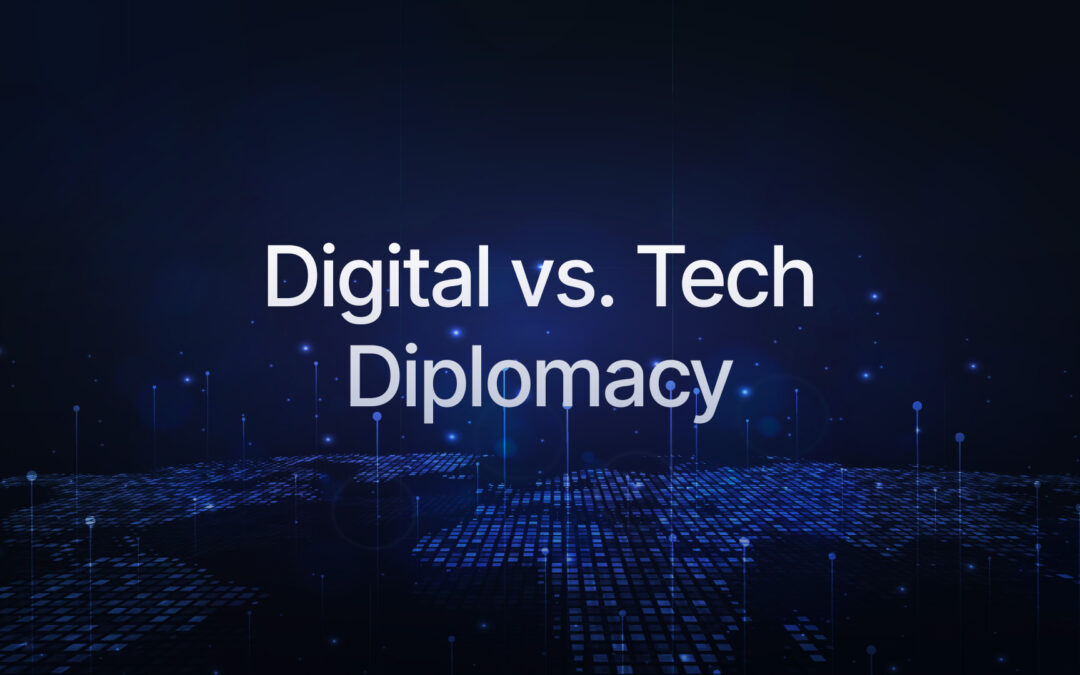The rapid digitalization of international relations has generated considerable terminological confusion, with concepts like digital diplomacy, tech diplomacy, cyber diplomacy, and e-diplomacy often used interchangeably in policy discussions and academic literature. However, these terms represent distinct approaches to technology’s role in diplomatic practice, each with specific scope, objectives, and methodological frameworks. The proliferation of technology-related diplomatic terminology reflects the broader challenge of conceptual clarity in rapidly evolving fields where practice often precedes theoretical development. As the U.S. Government Accountability Office has noted, this “lack of a universally agreed-upon definition” represents one of the main challenges for effective technology diplomacy implementation. Understanding the precise differences between digital diplomacy and tech diplomacy becomes particularly important as governments establish specialized diplomatic positions and develop institutional frameworks for technology governance in the digital age, requiring clear role definitions and strategic coherence across different technology-related diplomatic functions.
Scope, Orientation, and Fundamental Distinctions
Digital diplomacy encompasses both the tools and substantive topics related to information and communication technologies in diplomatic practice. As defined by Ilan Manor, digital diplomacy involves “the growing use of ICTs and social media platforms by a country in order to achieve its foreign policy goals and practice public diplomacy.” This definition emphasizes digital diplomacy’s dual nature: it includes both the practical applications of digital tools for conducting diplomatic activities and the governance of internet-related policy areas such as online human rights, privacy protection, disinformation management, content moderation, and cross-border data flows. Digital diplomacy practitioners focus on optimizing communication effectiveness, managing online diplomatic presence, engaging diaspora communities through digital channels, and participating in internet governance forums.
In contrast, tech diplomacy adopts a significantly broader scope that encompasses digital issues while extending to the full spectrum of emerging technologies and their governance implications. Tech diplomacy addresses critical technologies including artificial intelligence, semiconductors, quantum computing, robotics, blockchain, synthetic biology, and other innovations that reshape economic structures, security frameworks, and social organization. This expanded scope reflects tech diplomacy’s focus on the intersection between technological innovation and international relations, rather than specifically on digital communication tools and internet governance. Tech diplomacy practitioners engage directly with technology development ecosystems, participate in technology standards-setting processes, and address the geopolitical implications of technological innovation and deployment across multiple domains of international affairs.
Information Power versus Innovation Power: Conceptual Frameworks
The fundamental distinction between digital diplomacy and tech diplomacy lies in their respective emphases on information power versus innovation power, reflecting different conceptualizations of how technology intersects with diplomatic influence and international relations. Digital diplomacy primarily leverages information power—the capacity to generate, process, and disseminate information through digital channels to influence international audiences, shape public opinion, and achieve foreign policy objectives. This approach focuses on communication strategies, narrative construction, and the use of digital platforms for public diplomacy, cultural exchange, and international engagement. Digital diplomats work to optimize message reach and effectiveness, manage online reputation and engagement, and address challenges such as disinformation and online harassment that can undermine diplomatic communication effectiveness.
Tech diplomacy, conversely, centers on innovation power—the capacity to innovate, regulate, and integrate transformative technologies within diplomatic and governance frameworks. This involves engaging with the entities and processes that develop new technologies, establishing regulatory frameworks for emerging innovations, and participating in international standard-setting activities that shape technology development trajectories. Tech diplomacy recognizes that control over technological development and deployment represents a fundamental source of power in contemporary international relations, requiring diplomatic engagement with innovation ecosystems rather than merely communication through digital channels. This distinction reflects different theories of power in international relations, where information power focuses on influence through communication while innovation power emphasizes influence through control over technological capabilities and governance processes.
Practical Applications and Institutional Implementation
The practical applications of digital diplomacy typically involve virtual diplomatic activities, social media engagement, digital public diplomacy campaigns, online cultural programming, and the management of digital diplomatic platforms. Digital diplomats focus on optimizing communication effectiveness through various digital channels, managing online reputation and crisis communication, engaging diaspora communities and international audiences through social media and digital platforms, and addressing internet governance issues within established multilateral frameworks such as the Internet Governance Forum and International Telecommunication Union. These activities often involve collaboration with communication specialists, digital marketing professionals, and public diplomacy practitioners who bring expertise in digital communication strategies and online engagement techniques.
Tech diplomacy applications extend to direct engagement with technology companies on policy development and regulatory compliance, participation in technology standard-setting organizations and technical committees, negotiation of international agreements on emerging technologies and innovation cooperation, and the development of national technology strategies that address global competitiveness and security considerations. Tech diplomats work within innovation ecosystems, engage with venture capital networks and startup communities, participate in technology policy forums and industry conferences, and coordinate international approaches to technology governance challenges that transcend traditional internet-focused digital policy frameworks. These activities require technical expertise, understanding of innovation processes, and familiarity with technology industry dynamics and business models.
Overlapping Areas and Complementary Functions in Practice
Despite these distinctions, digital diplomacy and tech diplomacy occupy overlapping terrain and serve complementary functions within contemporary diplomatic practice, reflecting the interconnected nature of digital and technological systems in modern international relations. Both fields address the transformative impact of technology on international relations and require specialized expertise that transcends traditional diplomatic training and conventional foreign policy frameworks. The intersection becomes particularly evident in areas such as data governance, where digital diplomacy’s focus on cross-border data flows and internet governance converges with tech diplomacy’s broader concern for data sovereignty, artificial intelligence governance, and privacy protection frameworks.
Cybersecurity represents another area where digital and tech diplomacy approaches intersect and complement each other, as cyber threats require both digital communication strategies for international coordination and technical cooperation on technology standards and security protocols. Platform governance issues similarly involve both digital diplomacy considerations regarding content moderation and online speech, and tech diplomacy engagement with technology companies on algorithmic transparency, artificial intelligence ethics, and regulatory compliance. These overlapping areas suggest that effective technology governance in international relations requires coordination between digital and tech diplomacy practitioners, rather than strict separation of their functions and responsibilities.
Strategic Implications and Future Development
The distinction between digital diplomacy and tech diplomacy has important strategic implications for diplomatic institutions, training programs, and international cooperation frameworks. Understanding these differences enables more effective allocation of diplomatic resources, clearer role definition for specialized diplomatic positions, and better coordination between different technology-related diplomatic functions. As technology continues to evolve and create new challenges for international relations, both digital and tech diplomacy approaches will likely become more specialized and sophisticated, requiring continued conceptual refinement and institutional development.
Conclusion
Understanding the distinction between digital diplomacy and tech diplomacy provides essential clarity for developing effective institutional responses to technology’s impact on international relations. While digital diplomacy optimizes communication and addresses internet governance through information power, tech diplomacy engages with the broader innovation ecosystem that shapes technological development and deployment through innovation power. Both approaches are necessary for comprehensive diplomatic engagement with technology’s transformative effects, but they require different skills, institutional frameworks, and strategic orientations to achieve their respective objectives effectively. As the field continues to mature, maintaining conceptual clarity while recognizing practical intersections will be essential for effective technology governance in international relations.
References
Manor, I. (2019). The digitization of public diplomacy. Palgrave Macmillan.
Garcia, E. V. (2022). What is tech diplomacy? A very short definition. Digital Diplomacy Papers, 1(3), 12-18.
Bjola, C., & Holmes, M. (2015). Digital diplomacy: Theory and practice. Routledge.
Kaltofen, C., & Acuto, M. (2018). Overlap and contest: Tech governance in the grey zone. Global Policy, 9(3), 39-46.
U.S. Government Accountability Office. (2023). Cyber diplomacy: Challenges and opportunities for U.S. engagement. GAO Report 23-105.
Cassidy, J. (2023). Information power vs innovation power: Conceptualizing diplomatic influence in the digital age. International Affairs, 99(4), 1567-1584.

